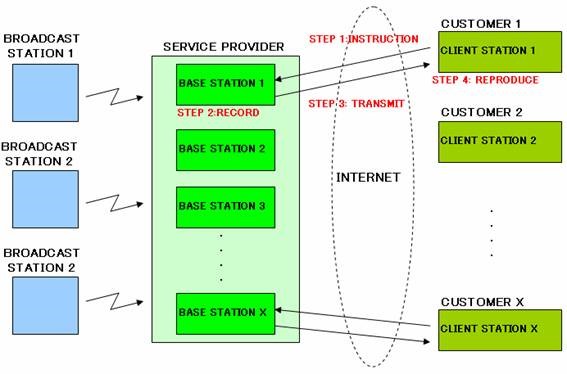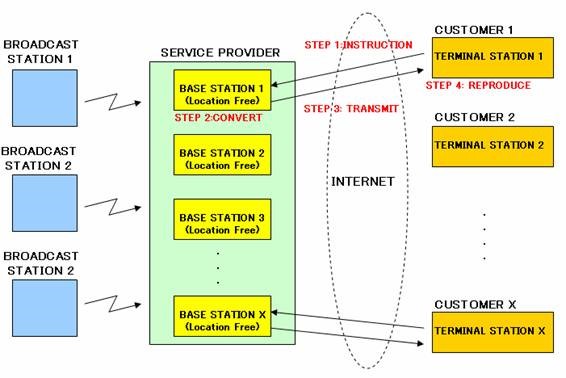Home > News & Topics > IP Court Case Summary:INTERNET COMMERCIAL SERVICE OF RECORDING AND TRANSMITTING TELEVISION PROGRAMS FOR CUSTOMERS CONSTITUTES INFRINGEMENT OF COPYRIGHT
IP Court Case Summary:INTERNET COMMERCIAL SERVICE OF RECORDING AND TRANSMITTING TELEVISION PROGRAMS FOR CUSTOMERS CONSTITUTES INFRINGEMENT OF COPYRIGHT
The Supreme Court issued two landmark decisions “ROKURAKU-II” and “MANEKI TV” on January 21 and 18, respectively, in terms of copyright law, in which the lower court decisions that internet-based commercial services receiving TV programs for customers and transferring them to the customers through internet do not constitute infringement of copyright were reversed and the cases were remanded to the lower court for further consideration.
ROKURAKU-II : H21(Ju)No. 788
Background
The defendant company, NIHON DIGITAL CO., LTD (NYX) manufactures, sales, and leases an internet-based communication system ROKURAKU-II consisting of a pair of devices, i..e, base and client stations. The base station has a TV tuner installed therein for receiving analogue terrestrial broadcast signal of TV program, converting the received analogue signal to digital signal, and transmitting the converted digital signal through internet. The client station is designed to transmit a signal to the associated base station through internet, instructing the base station to transmit the recorded TV program to the client station where the TV program is reproduced by the customer. The base stations are kept and administered by the service provider NYX and the client stations are kept by the customers of the service living outside Japan, for example. In operation, the customer operates his or her client station to instruct the associated base station away from the client station through internet for recording a specific TV program. The instruction is transmitted through internet to the associated base station (STEP 1). Upon receipt of the instruction, the base station records an analogue TV program designated by the instruction (STEP 2). The recorded TV program is then converted into digital data which is transmitted to the client station through internet (STEP 3). The TV program received by the client station is then reproduced by the customer for watching (STEP 4).

District and High Court’s Decisions
The district and the Intellectual Property High Court rejected Broadcast Station’s complaint on the ground that the base stations were kept at a site administered and managed by NYX but NYX simply provides a circumstance or condition where customers are easy to make copies of TV programs. Therefore, it should be said that NYX was not making copies of the TV programs.
Supreme Court Decision
The Supreme Court reversed the lower court decision unanimously and remanded the case to the Intellectual Property High Court because the lower court erred in the factual finding that who copied the TV programs. Specifically, the Supreme Court said as follows:
In terms of services which allows customers to obtain reproductions of, for example, TV programs, if the service provider receives TV programs through TV antenna to record them in a copying machine and the copying of the TV programs is performed automatically upon receipt of the recording instruction by the copying machine, it should be understood that the service provider is the person who made the copying of the TV program even when the copying instruction is made by the customer of the service.
Specifically, in order to determine who copied the programs, considerations should be made to various matters such as copying objects and methods, commitment to copying, and copying degree. In this case, the service provider has been taking a major role in copying TV programs by the use of copying devices, not only providing a circumstance facilitating copying of the programs but also receiving the program-related information and recording the same into the copying devices under its control. Also, without those conducts made by the service provider, it is extremely difficult to copy the TV programs even if the customers send out instructions for copying, which means that there exists good reason to determine that the service provider is the person who copies the TV programs.
In view of the foregoing, it is evident that the lower court who ruled that NYX could not be said to be the person who copied the TV programs even if the base station is kept in a place administered by NYX without considering the circumstance in which the base station for this service is administered, made an error which affected the decision. Therefore, the court remands the case to the lower court for further consideration.
http://www.courts.go.jp/hanrei/pdf/20110120144645.pdf
MANEKI TV : H21(Ju)No. 653
Background
The defendant company Nagano Shokai (hereinafter referred to as “Nagano”) provides an internet-based service, under the trade-name “Maneki TV”, for receiving and transmitting TV programs at customer’s request. For this service, used is an audio device or base station which is commercially available from SONY under the trade-name Location FreeR. The base station incorporates a TV tuner for receiving analogue terrestrial broadcast signal and converting the received signal into digital data which is then automatically transmitted to the associated terminal station away from the base station through internet. The base stations are kept and administered at data center of Nagano while the terminal stations are kept by respective customers.
In operation, the customer operates his or her terminal station to generate an instruction to the associated base station for transmitting signal of a specific TV program. The signal is transmitted through internet to the associated base station at the data center of the service provider (STEP 1). The base station is continuously receiving analogue terrestrial broadcast signal. Upon receipt of the instruction, the associated base station converts the analogue data to digital data (STEP 2). The digital data is automatically transmitted through internet to the terminal station of the customer from which the instruction was issued. The customer operates the terminal station to reproduce the received TV program (STEP 4).

District and High Court’s Decisions
The district and the Intellectual Property High Court rejected Broadcast Station’s complaint which argues that Nagano’s service for receiving TV programs by the base stations for customers and then transmitting the same to generate a condition in which the customers are able to watch the TV programs infringed Right to make transmittable under Article 99(ii) and also Nagano’s service for transmitting TV programs to the public or terminal stations of the customers infringed Right of public transmission, etc. under Article 23 (1).
Supreme Court Decision
The Supreme Court reversed the lower court decision unanimously and remanded the case to the Intellectual Property High Court on the basis of following reasons.
A. Infringement of Right to make transmittable
(1) “To make transmittable” means making an automatic public transmission possible by any of the acts set out in the Article 2(1)(ix) of the Copyright Law, such as inputting information into an automatic public transmission apparatus connected to an electric communication line provided for the usage of public. Also, “automatic public transmission apparatus” means an apparatus which, when connected to a public communication line provided for the public use, functions to place information in an environment of automatic public transmission which is either recorded on a portion of a recording medium thereof or is input therein (Copyright Law Article 2(1)(ix-5)).
The “automatic public transmission” is a one aspect of the public transmission (Copyright Law Article 2(1) (ix-4)), and the “public transmission” is a transmission of signal which would be directly received by the public when viewed from a transmitter point of view. A purpose that the copyright law includes making transmittable as a subject to control is to preclude preparatory activities that may lead an automatic public transmission under the condition that an automatic transmission which is performed in response to requests from the public is already regulated. In view of the foregoing, an apparatus having a function to communicate with a public electric communication line and then to make an automatic transmission of information received by the apparatus in response to a request from the receiver should be an automatic public transmission device if the transmission performed by the use of this apparatus can be said to be an automatic public transmission.
(2) Considering the fact that the automatic public transmission is based upon the usage of a device having a function to make an automatic transmission of information received by the device in response to a request from a receiver, it should be construed that a person who makes the automatic transmission is the one who makes a condition in which an automatic transmission of information can be made in response to a request from the receiver. Also, it should be construed that a person who inputs information into the device is the person who transmits the information if the device is communicated with the publicly usable electric communication line and information is always being input into the device.
(3) In this case, each base station has a function which allows the base station to automatically convert input information into digital data and transmit the data in response to a request from the receiver when the base station is connected to the internet. Also, in order to perform the service, the base station is connected to the internet, which allows information to be continuously input into the base station. Further, Nagano connects the base stations through a divider to his TV antenna and sets the base stations so that the broadcast programs received by the antenna are continuously input into the base stations. In addition, the base stations are kept and administered in Nagano’s office. Therefore, even if the base stations are owned by the customers, it should be construed that a person who inputs the broadcast programs and transmits TV programs using the base stations is Nagano. Also, any person can make a service contract with Nagano to use the service. Then, from Nagano’s point of view, the customer of this service is an unspecified public. Accordingly, the transmission which is performed using the base station is the automatic public transmission and, as a result, the base station is the automatic public transmission device. In conclusion, it should be understood that inputting TV programs into the automatic public transmission device or base station connected to the internet is to make the broadcast transmittable.
B. Infringement of Right of Public Transmission
In this service, it is evident that Nagano receives the broadcast signal from the antenna and transmits it to the base stations. Also, as described above, it should be said that Nagano transmits the signal from the base stations to the associated terminal stations. Therefore, a transmission of the TV programs to the terminal stations of the customers should be the public transmission of the programs.
http://www.softic.or.jp/Ysemi/2010/8_110304/m_20110118.pdf

